
The Peninsula Campaign
March - May 1862
Thirty five year old George McClellan had led a successful campaign in western Virginia early in the war, and as the only Union commander with significant success, Lincoln ordered him to take command of the defeated Army of the Potomac soon after the First Manassas debacle in July 1861. Although McClellan had organizational talent, he was secretive, which annoyed the President, and he would prove to be overly cautious, among other flaws. In the spring of 1862, he was finally ready to begin an offensive.
Mac's original plan was to transport his army through the Chesapeake Bay for a landing at Urbanna on the Rappahannock River. There, he would be closer to Richmond than his Confederate opponent, Joe Johnston, who was at Manassas, and the Yankees would be able to reach the Confederate capital with a few short marches. Johnston, however, began to withdraw his army south to the Rappahannock, forcing McClellan to change his plan. Clinging to the amphibious concept, he decided to instead land at Fortress Monroe at the tip of the James / York Peninsula. From there, he would advance west on Richmond.


Fort Monroe would be McClellan's supply base during the campaign. Being connected to the mainland only by a narrow causeway, Fortress Monroe had not fallen to the Confederates during the secession crisis. Fort Monroe and Fort Wool, which had been built on a man-made island, dominated the opening to the James River, seemingly making the lines of communication safe. |
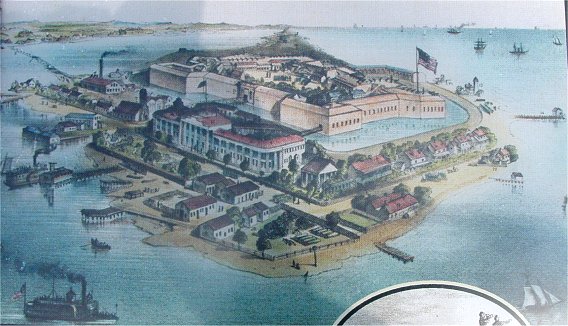 |
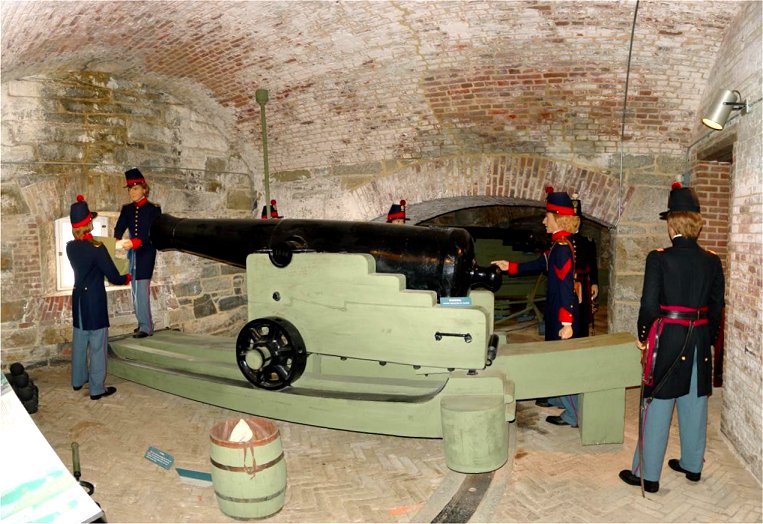
This exhibit in the fort's Casemate Museum shows a gun crew loading their weapon.

Prior to the war, an engineering officer named Robert Edward Lee lived in the fort for a while, helping with its construction. He occupied the center-most of the three houses shown here. At this point in the war, Lee had failed in an attempt to recapture western Virginia and was serving as President Jefferson Davis's military advisor. At the end of the Peninsula campaign, he would take over command of Joe Johnston's army and optimistically name it the Army of Northern Virginia despite its being in the southern half of the state.
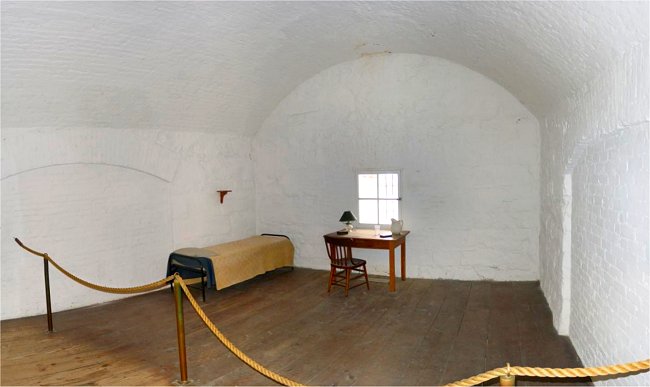
After Lee's surrender in April 1865, President Jefferson Davis was imprisoned at Fort Monroe in this casemate beginning in May 1865 on suspicion of being involved with the assassination of President Lincoln. In October, he was given better quarters. In 1867 he was released on bail, and in 1869, all charges were dropped.
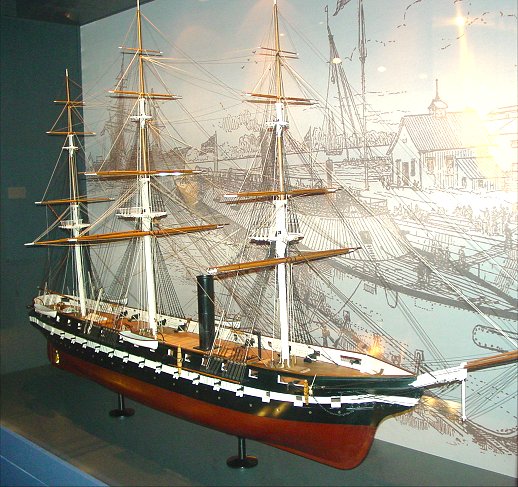 USS Merrimack becomes the .... |
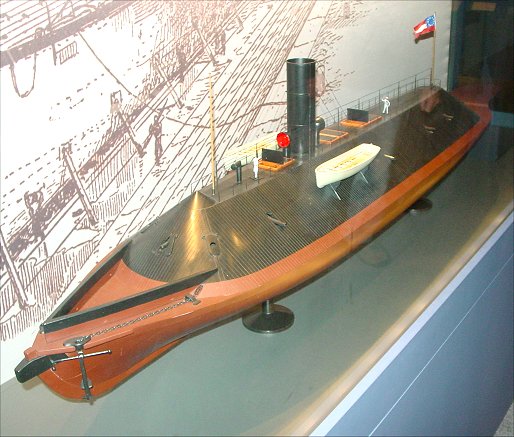 CSS Virginia |
"Gentlemen, We Can Rebuild Her - Better, Stronger, But Not Faster."
When Virginia seceded in 1861, the US Navy abandoned the navy yard in Norfolk. The USS Merrimack, a new steam powered frigate in dry dock, was burned. The docks were flooded, however, and the hull below the waterline survived. With minimal shipbuilding facilities and materials, the Confederates nevertheless converted the Merrimack into the CSS Virginia, with sloped iron armor. In March 1862, she sailed out into Hampton Roads and terrorized the wooden Union navy ships, sinking two of them. The next day, however, she would meet her equal.
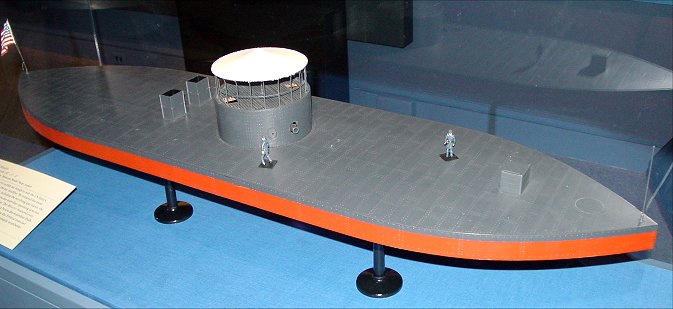
USS Monitor - A Cheese box On A Raft
John Ericsson, a native Swede, had been building and testing another ironclad in New York for the Union navy which had a single revolving turret mounting two 11 inch Dahlgren guns. The models above, below, and to the right are in the Mariner's Museum. On the right is the ship's steam engine, a two-cylinder vibrating lever engine, which was entirely below the waterline. The turret could be turned completely around in two minutes powered by two small steam engines. |
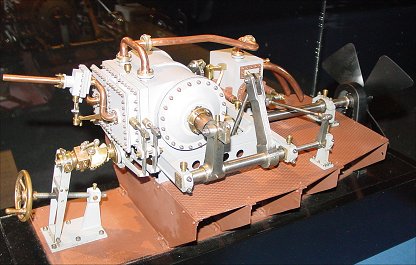
|
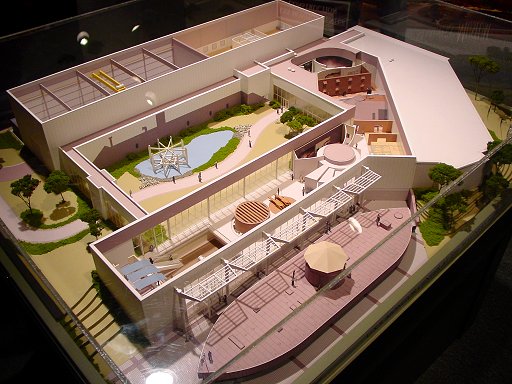
This model shows the area of the Mariner's Museum now under construction. ( - in 2006. It should be completed.) The turret and engine are being preserved in tanks in the distant rectangular building. A full-sized model of the Monitor is being built outdoors, and a mock-up of the turret will be in the adjacent section of the building. See the picture below. On the wall beyond the glass in the picture below, the CSS Virginia will be painted.
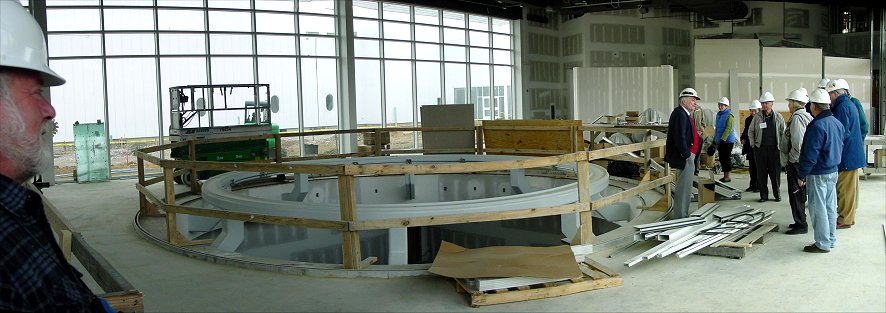

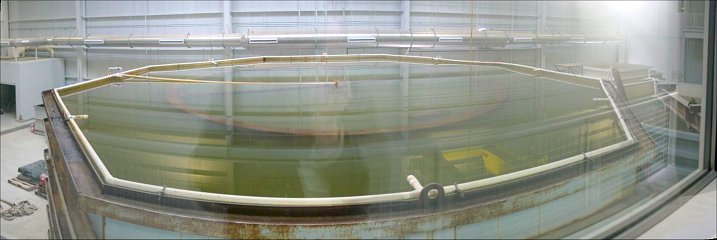
The turret is being stored upside down in the large tank, while the engine is in another tank. In the photo, you can see the bottom of the cylindrical turret.

Dam Number 1 Site at Warwick River Reservoir - From Union Side
McClellan knew little about the terrain or the enemy that he faced on the Peninsula. The Confederates under John Magruder were in three lines, an advanced line, a main line from Yorktown south along the Warwick River, and a third line near Williamsburg, where the Peninsula was only three miles wide. McClellan envisioned an amphibious turning movement to turn the enemy out of the first line, but this proved unnecessary. As the army continued to advance, Mac planned on encircling Yorktown and besieging any Confederate garrison in the town. These plans were soon dashed when Yankees advancing through the center of the Peninsula came upon the Warwick River and strong Confederate earthworks behind it. Now a drinking water reservoir, the river during the war was not by nature wide, but it had been dammed to a width of about 100 yards.
The Confederate earthworks were formidable, especially for this stage in the war. With only about 10,000 men, Magruder prominently marched his men into the entrenchments then secretly out of them only to once again make a showy entrance. This helped create the impression of strong Confederate numbers. McClellan decided that storming the works with his 100,000 men would be too costly. Ever the character, it is said that before the war Magruder had once been mailed to DC in drunken stupor. He would be removed from command following the Seven Days after asking Gen. Lee to help him with the flying monkeys in his tent.
W.F. "Baldy" Smith commanding a division of the Union IV Corps was on the lookout for weak points on the Confederate line. Winfield Scott Hancock, one of his brigade commanders, found one on April 6th, but he was halted by his superiors. By the 11th, Magruder had 34,000 men and Joe Johnston himself had arrived. Finally, on April 16th, McClellan ordered Smith to do something - to prevent the enemy from strengthening his lines at the weak spot, here at Dam Number 1. After an artillery bombardment by 18 guns, 192 men from several companies of the 3rd Vermont waded across the pond and captured some earthworks.

One Gun Embrasure
Union artillery fire had forced a single Confederate gun at the earthwork on the right of the modern trail to fall back. This had helped convince the Yankees that it was time to attack. The gun here, only one of three in the area, had protected the dam itself.
The attacking Yankees, in the area off the picture to the right, were counterattacked unsuccessfully by the 15th NC. The Vermont men expected reinforcements but didn't get any. When Cobb's brigade attacked them, the Yankees were forced back across the pond. In late afternoon, Smith ordered another attack, but a whole Confederate division was nearby, and the attack was doomed.
The Union probe had been promising, but is was not reinforced, and an opportunity to break the Confederate line had been lost along with 165 men. McClellan was not open to aggressive action.

Bluffs of Yorktown
Here on Yorktown's 90 foot bluffs at the northern end of the Confederate line, Southern artillery dominated the river below. At Yorktown and Gloucester Point, the river is constricted to the width of half a mile, which the modern bridge spans. Confederate forts on Gloucester Point also dominated the river. And since the CSS Virginia was still a threat in the James River, only seven ships of the Union navy were then available to support McClellan, and all of these ships were wooden. So both Confederate flanks, on th eJames, and on the York, were secure.

McClellan did have an option on the York River, one which he had previously planned on. McDowell's corps in northern Virginia was scheduled to join, by sea, McClellan's army. These men would come ashore north of the York River and capture Gloucester Point, including this star-shaped landward-facing fort. Stonewall Jackson in the Shenandoah Valley, however, distracted Union attention, and President Lincoln ordered McDowell's corps to remain in Northern Virginia. McClellan, an inflexible and plodding thinker, did not consider using other troops.

Confederate Defenses in Front of Yorktown
Confederate defenses were weakest near Yorktown itself, with no creek or river for a barrier. The defenses were built along the same general line as the British defenses during the 1781 siege, resting on the river itself, visible on the left background of the picture, but the Southern defenses were much stronger than the British ones. During the 1781 siege, low ground to the front of the line had inspired the construction of Redoubts 9 and 10. The Confederates placed rifle pits in the same area.
Wormley Creek, which enters the York River near the area of the smokestack, was used by the Federals to bring up the heavy siege guns by water. Because of advances in artillery technology, the 1862 siege lines started much further out than in 1781.

Union Battery 6
This mortar battery near the 1781 surrender field isn't even interpreted by the park service. The surrender field is just beyond the brick overlook building on the left, and additional Union earthworks are on the far side of the field, just waiting for you to explore with a good map from the Official Atlas. May 5th was the day that McClellan set for the Union batteries to open up. According to doctrine, opening fire before all the batteries were ready was counter-productive and would likely lead to defeat in an artillery duel. Only a single Union battery had fired 141 rounds during the "siege". The Confederates knew that they couldn't stand up to the Union siege. On the night of May 3rd, they opened up with all that they had - then abandoned their entrenchments. In the abandoned town, the southerners left landmines, devices seen as barbaric and inhuman. Confederate prisoners of war were detailed to dispose of them.
All the delays at Warwick River and Yorktown had given Joe Johnston time to bring his army south to protect Richmond. McClellan's plan for a quick and easy victory had evaporated.
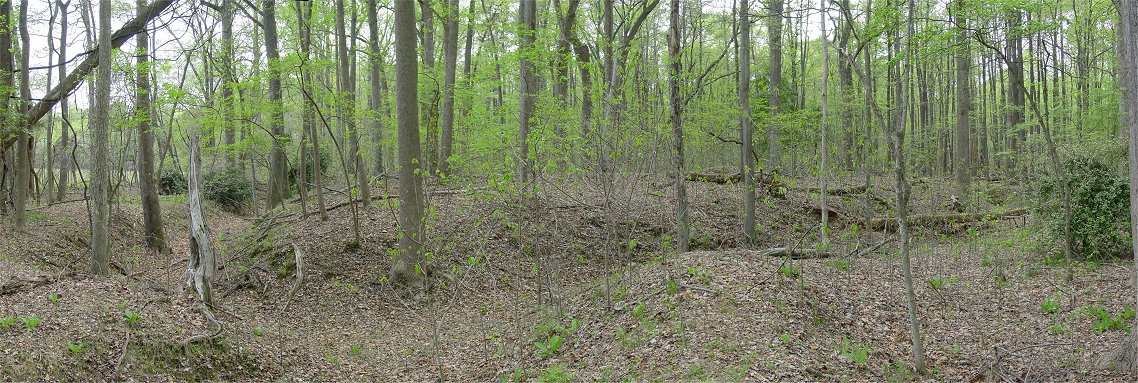
Battery in Front of Surrender Field
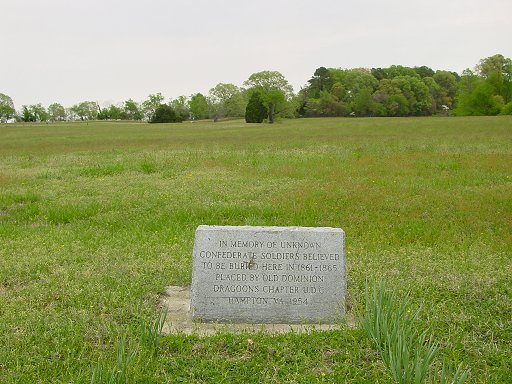
This mass grave can be found to the rear the American section of 1781 second siege line.

Battle of Williamsburg - Fort Magruder (which is not in a hotel parking lot)
With Confederate withdrawal, McClellan had the opportunity to send an amphibious force up the York River to cut off the Confederate retreat. Believing that he faced a large rebel force, Mac declined this option - for now. His land-bound pursuit was slow and poorly coordinated.
On May 5th, Union troops amounting to 18,500 men in two divisions reached the Confederate rearguard at Williamsburg, where the third Confederate line defended the narrow 3 mile wide Peninsula. Another three divisions were nearby but were not committed. McClellan showed no inclination to take command. While Yankees under Joe Hooker were engaged near Fort Magruder, one of a number of Confederate earthworks on the line, a Union flanking column of 3,400 men under Winfield Scott Hancock was sent north to cross a dam over Cub Creek to flank the Confederate position. There they repulsed a confused counterattack by Jubal Early, and for this Hancock was given the title "Superb" by McClellan.
The Confederates lost over 1,600 men of 13,750 engaged to Union losses of 2,200. That night, the Confederates continued the withdrawal from the rainy battlefield in safety.

Cub Creek Dam and the Colonial Parkway

The menace posed by the CSS Virginia was surprisingly enough ended in part due to the advice of President Lincoln, who visited Fort Monroe and stayed in the house prominent in the center of the above panorama. Lincoln suggested an amphibious landing near Norfolk, which, when executed on May 10th, led the Confederates to abandon Norfolk. The CSS Virginia required the relatively deep port at Norfolk to operate, so the ship was doomed. The Confederates blew the ship up rather than let it fall into Union hands. Even without the landing, however, Norfolk was likely to fall as either McClellan's advance up the Peninsula or Burnside's pressure from North Carolina could have led to the same result. |
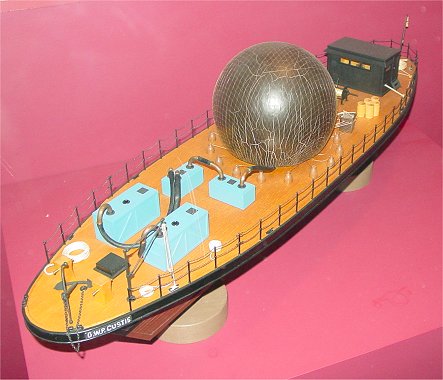 |

Interior of Fort Darling at Drewry's Bluff
The Union Navy was now able to advance on Richmond up the James River. This was easy along the river's wider parts, but grew more difficult farther up the river. At Drewry's Bluff, seven miles downriver from Richmond, the Confederates had constructed Fort Darling with heavy guns in a commanding position 90 feet above the James. (In this panorama, the fenced-off sunken area is a collapsed bombproof.)

View From Drewry's Bluff
This pan shows the commanding position of the fort overlooking a bend in the river. Early on May 15th five Union vessels approaching from the right of the panorama, including the Monitor and another ironclad, the Galena, anchored downriver from Fort Darling and began bombarding the fort. The big Confederate guns responded with Southern infantrymen on the shore adding small arms fire into the mix. After about four hours, the Union navy ceased fire, giving up the naval attempt on Richmond.
McClellan's land advance also stalled several miles from Richmond, with the army divided by the Chickahominy River. Taking advantage of this, Joe Johnston attacked in the battle of Seven Pines on May 31st. A good plan miscarried, however, and Johnston was wounded. President Jefferson Davis was on the field and appointed his military advisor, Robert Edward Lee, to replace him. Ordering his men to entrench, "Granny" Lee became derisively known as "the King of Spades". McClellan's appraisal was no better. "I prefer Lee to Johnston. The former is too cautious and weak under grave responsibility -- personally brave and energetic to a fault, he yet is wanting in moral firmness when pressed by heavy responsibility and is likely to be timid and irresolute in action." After the Seven Days Campaign, many observers would come to other conclusions.
Back to Civil War Virtual Battlefield Tours